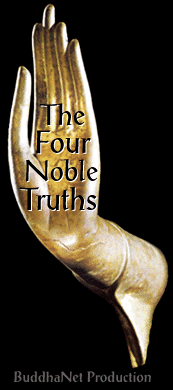The Four Noble Truths are a tool for understanding stress.
Each of The Four Noble Truths have three aspects.
They are a lifetime’s reflection.
Introduction
-
The Noble Truth of Suffering.
-
The Noble Truth of the Origin of Suffering.
-
The Noble Truth of the Cessation of Suffering.
-
The Noble Truth of the Way Leading to the Cessation of Suffering.
The Four Noble Truths are:
- there is suffering
- there is a cause of suffering
- there is a end of self-suffering
- there is path out of self-suffering
Three Aspects
Each of these Noble Truths has, three aspects. All together there are twelve insights.
- There is the statement
- The prescribed practice
- The result of having practiced
In the Theravada school, an arahant, a perfected one, is one who has seen clearly the Four Noble Truths with their three aspects and twelve insights.
‘Arahant’ means a human being who understands the truth; it is applied mainly to the teaching of the Four Noble Truths.
The first insight of the First Noble Truth is:
‘There is suffering’
It is just the recognition: ‘There is suffering’. That is a basic insight.
First Noble Truth; it is not: ‘I am suffering and I want to end it.’ The insight is, ‘There is suffering’.
Now you are looking at the pain or the anguish you feel – not from the perspective of ‘It’s mine’ (self-sufferingL but as a reflection:
‘There is this suffering, this dukkha’. It is coming from the reflective position of ‘Buddha seeing the Dhamma.’ The insight is simply the acknowledgment that there is this suffering without making it personal (self-sufferingL.
That acknowledgment is a very important insight; just looking at mental anguish or physical pain and seeing it as dukkha rather than as personal misery – just seeing it as dukkha and not reacting to it in a habitual way.
The second insight of the First Noble Truth is:
‘Suffering should be understood.’
The second insight or aspect of each of the Noble Truths has the word ‘should’ in it: ‘It should be understood.’ The second insight then, is that dukkha is something to understand. One should understand dukkha, not just try to get rid of it.
We can look at the word ‘understanding’ as ‘standing under’. It is a common enough word but, in Pali, ‘understanding’ means to really accept the suffering, stand under or embrace it rather than just react to it.
Responding Vs Reacting
With any form of suffering – physical or mental – we usually just react. But if we respond with understanding we can really look at suffering; really accept it, really hold it and embrace it.
The third aspect of the First Noble Truth is:
‘Suffering has been understood.’
When you have actually practiced with suffering – looking at it, accepting it, knowing it and letting it be the way it is – then there is the third aspect, ‘Suffering has been understood’, or ‘Dukkha (stress) has been understood.’
Summary
So these are the three aspects of the First Noble Truth:
- ‘There is dukkha’
- ‘It is to be understood’
- ‘It has been understood’
This is the pattern for the three aspects of each Noble Truth.
- There is the statement
- The prescribed practice
- The result of having practiced
One can also see it in terms of the Pali words pariyatti, patipatti and pativedha.
- Pariyatti is the theory or the statement, ‘There is suffering.’
- Patipatti is the practice – actually practicing with it.
- Pativedha is the result of the practice.
This is what we call a reflective pattern; you are actually developing your mind in a very reflective way.
A Buddha mind is a reflective mind that knows things as they are.
The Second Noble Truth of the Origin of Suffering.
There is a cause of my suffering. We apply the four noble truths to ordinary things in our lives, to ordinary attachments and obsessions of the mind. With these truths, we can investigate our attachments in order to have the insights. With these new insights we learn more about the nature of human life.
The Third Noble Truth of the Cessation of Suffering.
Through the Third Noble Truth, we can realize cessation, the end of self-suffering, and practice the Eightfold Path until there is understanding.
The Fourth Noble Truth of the Way Leading to the Cessation of Suffering.
When the Eightfold Path has been fully developed, one is an arahant. Even though this sounds complicated – four truths, three aspects, twelve insights – it is quite simple. It is a tool for us to use to help us understand suffering and non-suffering.
The Four Noble Truths are a lifetime’s reflection.
It is not just a matter of realising the Four Noble Truths, the three aspects, and twelve stages and becoming an arahant on one retreat – and then going onto something advanced. The Four Noble Truths are not easy like that. They require an ongoing attitude of vigilance and they provide the context for a lifetime of examination.
Source- THE FOUR NOBLE TRUTHS, Teachings by Ajahn Sumedho
Adapted by G Ross Clark

